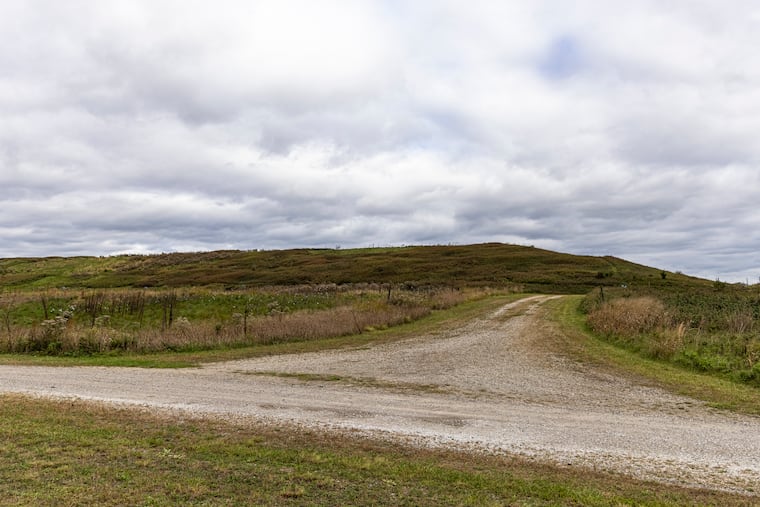Once a notorious Superfund, South Jersey landfill property soon will power hundreds of homes with solar
The 60-acre GEMS landfill in Gloucester Township, laden with industrial waste, asbestos, solvents and heavy metals, will become the site of a new 4.5 megawatt solar array.

The 60-acre GEMS landfill in Gloucester Township, Camden County, was once one of the most notorious Superfund sites in New Jersey, contaminating a nearby stream and soil with volatile organic compounds, arsenic, barium, lead, and pesticides.
Although the site has been closed since 1980 and mostly cleaned up since 2004, it still juts 100 feet above the local landscape as a symbol of the poorly managed landfills that once dotted many South Jersey towns.
On Wednesday, officials held a ceremonial groundbreaking for a 4.5-megawatt capacity solar array off Hickstown and New Brooklyn Erial Roads that they say will produce enough energy to power hundreds of homes. Construction will start Nov. 19 and is scheduled to finish by spring.
“Today … Gloucester Township takes a gigantic leap forward in not only protecting our environment, but also taking one of the first Superfund sites in the nation, and making that site a beacon of sustainability,” said Mayor David R. Mayer.
The system will be built by Syncarpha Capital in partnership with Blue Sky Power, an energy consultant, and the township. The project entails building a 25-acre photovoltaic solar generation system on top of the existing cap for the landfill. Equipment includes modules, inverters, transformers, wiring, conduits, steel and aluminum racks, and rocks for ballast.
The array will connect to the regional grid through Atlantic City Electric. Under the arrangement, Syncarpha will assume the cost to build the array and sell the power. Syncarpha will pay the township about $40,000 a year under a 25-year lease, or about $960,000 over the life of the lease.
It’s estimated the array will produce more than 6 million kilowatt hours of clean energy a year. A typical New Jersey home uses about 8,902 per year, according to the federal Energy Information Administration. That would produce enough energy to power about 684 homes.
The township first signed a deal with Syncarpha in 2016 for the GEMS project, named after the last operator of the landfill, Gloucester Environmental Management Services Inc.
“We are very excited to see this GEMS project finally ready to begin construction,” Cliff Chapman, managing partner of Syncarpha Capital, said in a statement.
Chapman said the company had to work with the township to complete state, local, and environmental permitting, as well as establish the connection to Atlantic City Electric from the PJM regional wholesale electric grid.
Ben Parvey, CEO of Blue Sky Power, said the township’s other solar projects include schools and municipal locations totaling 7 megawatts, and a 4 megawatt system at a former Owens Corning landfill now dubbed Timber Creek Solar Park.
He called those projects, and now GEMS, “real transformation … those are real results.”
The original upper range for the GEMS project called for a system with a capacity of up to 10 megawatts, but Parvey said the township had to adhere to limits the grid could handle from that location.
The GEMS site was used as a landfill as far back as the 1950s, according to the U.S. EPA. From 1969 to 1980 municipal and industrial wastes were routinely dumped there. The landfill was closed by the New Jersey Department of Environmental Protection in 1980.
The EPA placed the site on its Superfund program’s National Priorities List in 1983 and created a plan to address the contamination that called for capping the landfill, and extracting and treating contaminated groundwater. Most cleanup was finished by 2004, but some remains.
The eastern edge of GEMS is bordered by the Holly Run stream, which flows into Briar Lake a quarter mile away. A system to collect contaminated water leaching from the landfill was placed under Holly Run, and the stream and nearby Briar Lake were part of the cleanup, as well as any issues with the municipal water supply system.
The federal government eventually reached a $30 million settlement with 252 separate parties in a legal process that took decades.
State Senate President Steve Sweeney, a prime sponsor of legislation that provides financial incentives for solar projects, was at the groundbreaking and called the GEMS project “a site that was dirty, cleaned up and now is going to promote clean energy.”